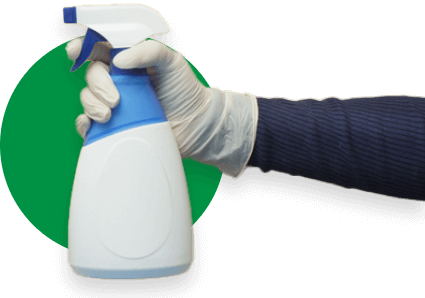A clean commercial bathroom improves customer satisfaction and keeps users healthy and hazards-free. Poor cleaning and maintenance can lead to unpleasant odors, unsightly stains, and the spread of harmful bacteria. In this expert guide, we’ll walk you through the steps to clean and maintain your commercial restroom for a pristine, welcoming environment.
Commercial Bathroom Hygiene & Its Impact on Business Image
The cleanliness of your commercial bathroom reflects your overall business practices. A recent study found that 78 percent of restaurant customers believe a clean restroom indicates a clean kitchen. Over 80% of the time in the restaurant industry, a visibly dirty bathroom drives customers away, causing them to lose trust in your services.
Poorly maintained restrooms can make customers and employees sick, negatively impacting your business. With the power of social media, unhappy customers can quickly spread negative word about your establishment, damaging your reputation. Prioritizing bathroom hygiene is crucial for customer experience, health and safety, and even your budget, as neglected restrooms may require costly repairs.
8 Steps on How to Clean Commercial Bathrooms
Implementing a systematic cleaning routine helps maintain safety standards and provides a comfortable experience for users. Follow these detailed steps to ensure your commercial bathroom is spotless and ready for use:
Gather Necessary Cleaning Tools and Materials

Collect all required cleaning equipment, products, and personal protective gear like gloves and goggles. Knock on the door to check if the bathroom is occupied, wait for it to clear, then block the entrance with a cleaning-in-progress sign.
Initiate Cleaning with Trash Removal
Overflowing trash cans look bad, making an otherwise clean bathroom appear neglected. Promptly empty full trash bags and replace them with clean liners. Disinfect the trash cans’ interior and exterior at least once a week or during a spill. Use a long-handled scrub brush to remove caked-on filth, then dry thoroughly before inserting a new liner.
Address High Touch Areas
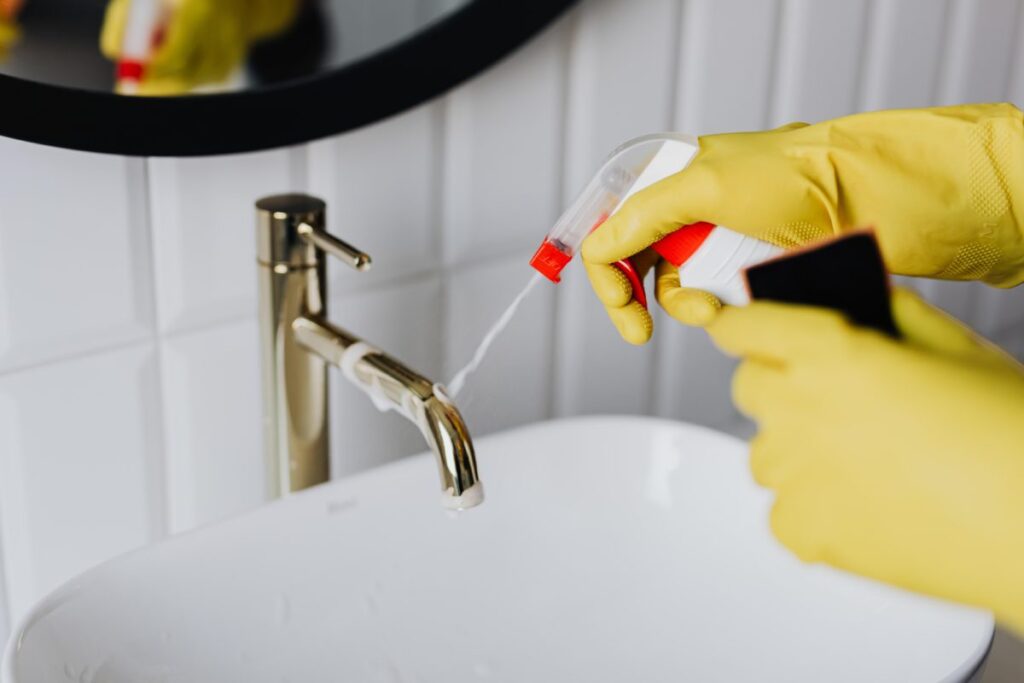
Apply cleaner/disinfectant to all high-touch point areas, including toilets, urinals, sinks, dispensers, and door handles. Allow the solution to sit for the recommended dwell time while you proceed with other steps. Cleaning and disinfecting are two procedures that should be completed to kill and remove germs from surfaces effectively.
Wipe All Mirrors and Windows
Spray and thoroughly wipe all mirrors using a window cleaner and cleaning cloth or paper towel. Clean any windows simultaneously, using a toothbrush or scrub brush to remove dirt from the tracks. Wipe the sill and casing with a surface cleaner. Blinds can be wiped down, and curtains should be washed weekly and replaced.
Deep Clean Toilets and Urinals
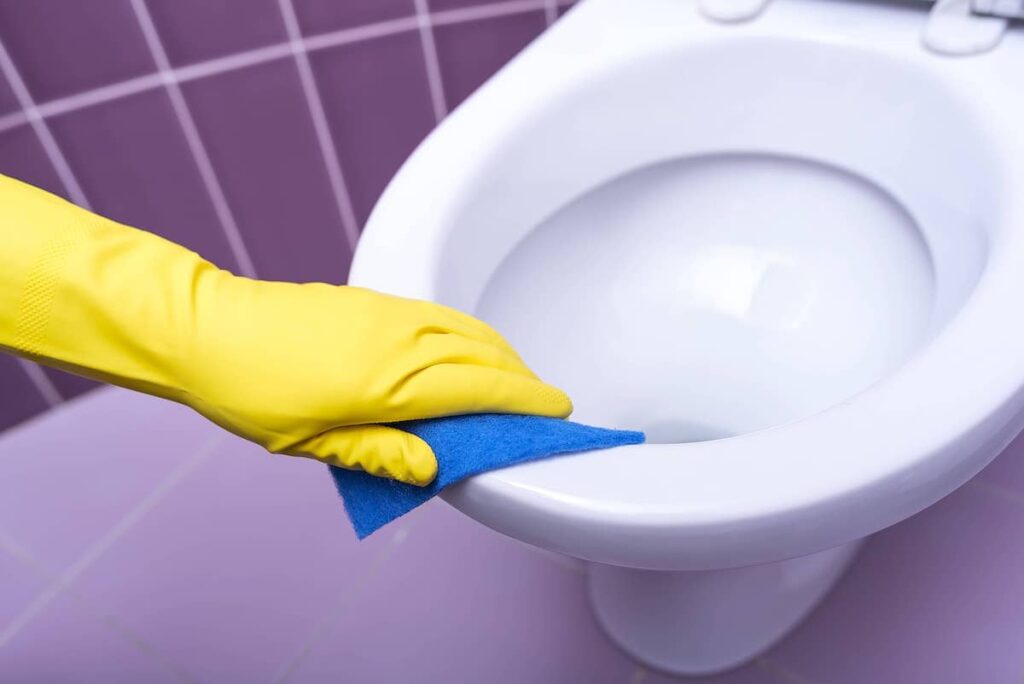
Squirt toilet bowl cleaner into the bowl and let it sit. Spray the outside of the bowl, base, and back with disinfectant, allowing it to break down grime while you scrub the inside, getting under the lip. Wipe down every external inch of the toilet, using a microfiber cloth to dry and remove all particles. Spend extra time on the seat and handle where most germs accumulate. Flush all toilets when finished to wash away cleaner and dirt.
Sanitize Sinks and Faucets
Wipe down sinks and counters, focusing on the handles. Use a scrub brush for built-up grime or stains and a toothbrush for crevices around handles and faucets. Disinfect soap, hand sanitizer, and paper towel dispensers anywhere patrons touch, refilling as needed. Dry everything with a clean microfiber towel to remove remaining particles and spots.
Scrub and Mop Floors
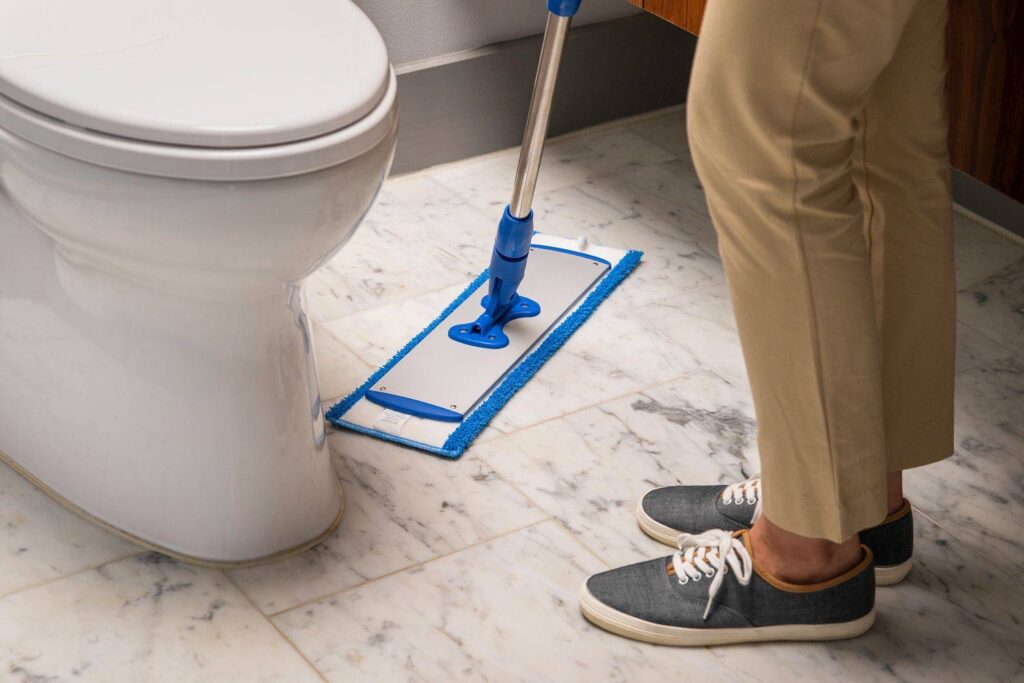
Sweep the floors thoroughly, using a brush to address dirt or grime in corners or tile crevices. Spray floor cleaner on the section you’re about to mop, ensuring your mop head is clean. Start in the back and work towards the door, bringing supplies and trash to avoid stepping on the clean floor.
Conduct Regular Bathroom Inspections and Maintenance
Inspect your work and report any necessary repairs or damage. Return all equipment, materials, and supplies to their storage areas, cleaning and maintaining them before putting them away. Ensure the area is dry before removing wet floor signs, as wet floors can lead to slips, falls, and injuries.
Tips for Maintaining Bathroom Cleanliness Over Time
Establishing daily, weekly, and monthly cleaning checklists for commercial bathrooms is vital to maintaining cleanliness. A sample daily cleaning routine may include:
- Emptying trash cans and replacing liners
- Restocking supplies like soap, hand towels, and toilet paper
- Sanitizing sensitive areas prone to bacteria, such as light switches, urinals, doors, changing stations, and toilets
- Disinfecting all surfaces
- Vacuuming or sweeping to pick up dirt
- Mopping the floor to remove stains and puddles
Periodic deep cleaning every 2-3 weeks, depending on bathroom traffic, should involve:
- Dusting ceilings, corners, fans, door frames, vents, and baseboards.
- Thoroughly wiping down toilet exteriors.
- Scrubbing floors with cleaning and waxing machines.
- Handling any necessary repairs.
Best Practices for Managers in Upholding Hygiene Standards
To ensure your commercial bathroom remains spotless, break down the cleaning approach into routine spot cleaning, daily restroom cleaning, and deep restroom cleaning.
Spot cleaning involves quick wipedowns of messy areas throughout the day. Daily cleaning is more thorough, ideally done during low-traffic hours, and includes emptying trash, restocking supplies, sanitizing sensitive areas, disinfecting surfaces, vacuuming or sweeping, and mopping.
Deep cleaning should occur every 2-3 weeks, during off-peak hours, and involves dusting, scrubbing toilets and floors, waxing, and addressing repairs. Assigning straightforward tasks and schedules to your team will help maintain consistently high hygiene standards.
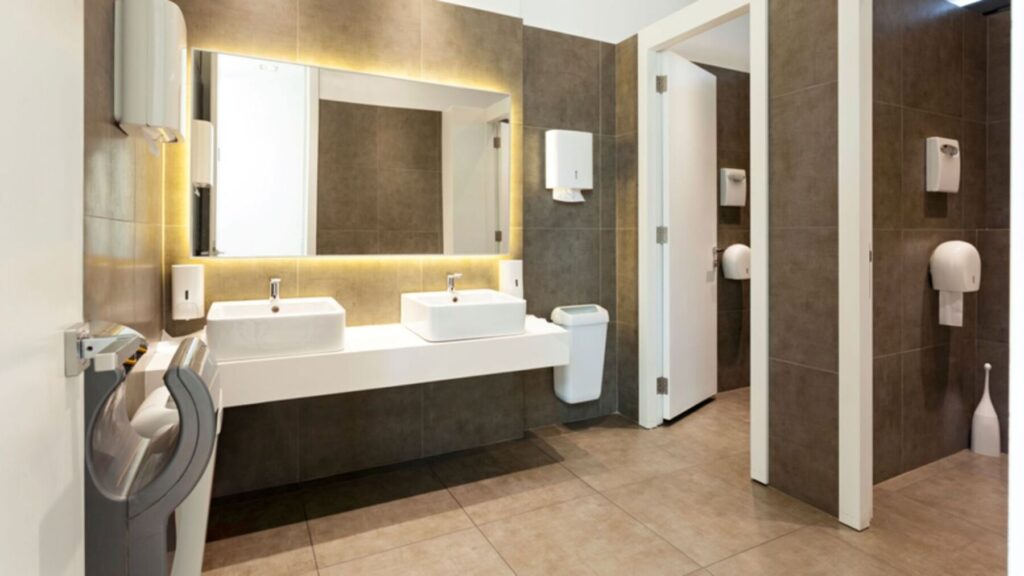
The Benefits of Professional Restroom Cleaning Services
While implementing regular cleaning routines is essential, professional cleaning services offer expert solutions for thoroughly cleaning bathrooms. With access to proper equipment and materials, they can address grout and other issues that may arise from neglected bathrooms.
Professional commercial sanitation services like those offered by Dallas Janitorial Services provide several key benefits:
- Easier daily maintenance, allowing your staff to maintain day-to-day cleanliness in less time
- Sanitized surfaces using formulated chemicals that leave a clean, pleasant scent
- High-pressure cleaning to remove build-up that brushes can’t reach, eliminating the need to touch contaminated surfaces
- Thorough removal of soil and odor-causing bacteria, preventing cross-contamination
- Reduced equipment needs, as you won’t need to stock auto scrubbers, vacuums, pressure washers, grout cleaning machines, etc.
Get Pristine Commercial Bathrooms with Expert Cleaning
Regularly cleaning and maintaining your commercial bathroom is essential for providing a sanitary, welcoming environment for customers and employees alike. By following the step-by-step cleaning process outlined in this article and implementing routine spot cleaning, daily cleaning, and periodic deep cleaning, you can prevent the spread of germs, extend the life of your restroom fixtures, and uphold your business’s reputation for cleanliness.
Consider hiring a professional cleaning service like Dallas Janitorial Services for a spotless commercial bathroom without the hassle. Our experienced team specializes in top-tier restroom sanitation, using advanced techniques and equipment to eliminate bacteria, prevent cross-contamination, and leave your bathroom smelling fresh. Don’t let a dirty restroom tarnish your business image – contact us today to schedule a cleaning and see why our customers consistently leave us glowing reviews.

FAQs About Cleaning Commercial Bathrooms
What is the most important thing to clean in a commercial bathroom?
People first look at the toilet when assessing a bathroom’s cleanliness. Use toilet bowl brushes with firm bristles and potent cleaning agents that won’t damage pipes. To maintain hygiene and prevent odors, it’s essential to thoroughly and regularly clean toilets.
What do professionals use to clean bathrooms?
Professional cleaners often use the same supplies as households: toilet bowl cleaner or bleach, disinfectant wipes, rubber gloves, non-scratch scrub sponges, microfiber cloths, or paper towels. A handheld scrub brush or pumice stone can be effective for tough stains.
What is the last step in cleaning a commercial bathroom?
The final step in the restroom cleaning procedure is emptying trash cans, replacing liners, and taking the trash to the dumpster. This crucial step helps keep your business appealing to employees and customers while protecting your bottom line.
Which chemical is used for bathroom cleaning?
Common bathroom cleaner ingredients include:
- Surfactants (anionic, non-ionic, cationic).
- Builders (polycarboxylate, NTA, trisodium methylglycine diacetate).
- Acids (citric, sulfonic, lactic, formic).
- Solvents like isopropanol.
How do hotels keep grout clean?
Hotels often use steam cleaning or machine scrubbers to professionally clean grout. These methods are highly effective and allow for the complete avoidance of chemicals.







